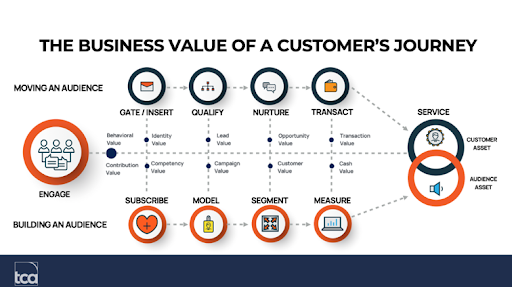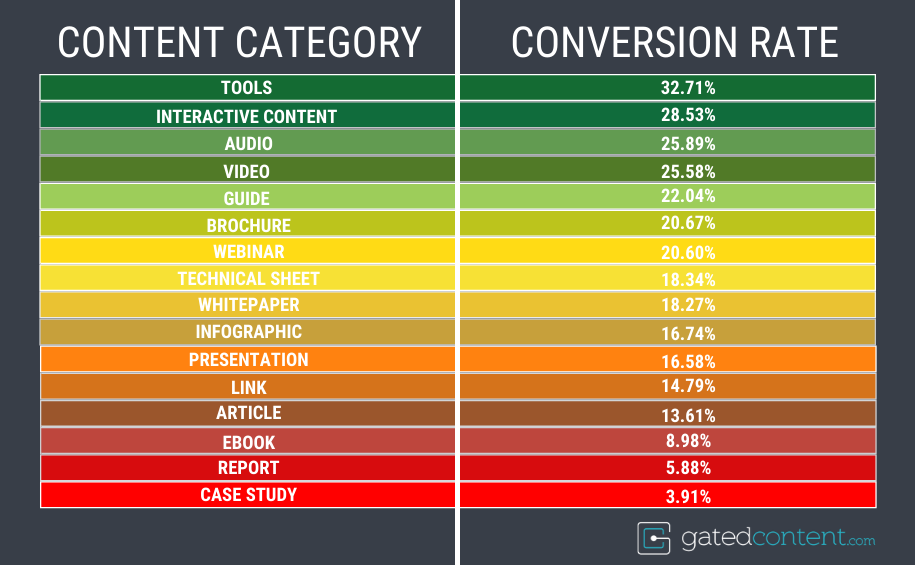Following on from our recent blog ‘To gate or not to gate? Content’s biggest question’ we thought it might be useful to delve a bit deeper. We’re using a combination of curated insights and GatedContent.com data to define some specific examples of the content types that drive the best response to gating, and not only that, where in the user journey you should be placing gates.
*Spoiler alert* the conclusion drawn from the previous blog that answered the question should content be gated, was that it depends on a number of factors. There are so many variables in a business, and marketing goals change over time so your content gating strategy should too. Ultimately we’d suggest a blended approach works best, but with that in mind, if you are going to gate content, it’s worth looking at where in the user journey you should be gating, and the best types of content to maximize conversion.
Let’s start with where to gate content
When we talk about where in this case we mean ‘where’ in the user journey. This is a more complex question than you might imagine. At a basic level, marketers feel under pressure to gate content because they don’t want to lose a potential customer by missing an opportunity to plant them firmly in the database for continued nurture. The mistake that’s often made here is a misunderstanding of which journey the user is embarking on.
According to the Content Marketing Institute, it’s critical to differentiate between a buyer journey and an audience journey. Gated content often is the very first step in a successful buyer’s journey. Awards have been given, case studies written, and budgets increased all because content marketing campaigns that lead to gated assets have produced results.
But, so too, have positive results come from content marketing with the intent of building an audience journey. These audiences may be filled with people who provide their contact information because they are genuinely interested in a future relationship with your brand through your consistent delivery of valuable content. Or they may never provide their details, but avidly follow you across social media. These individuals may never become a buyer, but they might become a significant brand advocate through content amplification.
This is the difference between a traditional revenue customer and a content customer, and that differentiation has an enormous impact on your content gating strategy. Before we look at that in more detail, it’s worth defining the value of a content customer. A revenue customer’s value is pretty obvious, but a content customer offers you the chance to significantly increase the size of your audience and thus the breadth of data you have access to, which feeds back into revenue growth by providing the opportunity to do the following:
- Continually provide for a database with which to improve targeted paid media efforts through lookalike audiences
- Give research insight into where you should increase marketing spend
- Inspire conversation to help develop better products and services
- Reach and influence other buyers that are proving to be difficult to reach with conventional methods
- Drive more valuable sales, or enable better cross-sell or upsell opportunities.
The diagram below from The Content Advisory illustrates the different journeys. Most importantly, it cites that content for buyer journeys should be designed to move an audience towards becoming a customer, and content for audience building is designed for longer term engagement, insight and advocacy.

In terms of where to gate content, in the buyer journey, gates would be used at entry and to provide an ongoing indication of where they’re at in relation to the objective of becoming a customer. Gates for an audience journey might be softer and may seek insight for broader marketing purposes, not to assess sales potential.
EXAMPLE
Gated buyer content
If you ran a webinar with a successful client to talk about how they’ve achieved that success with your help, the primary goal of this content would be moving your audience to the next phase of the buyer journey. You’d gate it, go out to your buyer group and track interest levels and lead scores. Follow up here might be an email promoting a demo. This is still high value and insightful content, but its intended purpose is revenue focused.
Gated audience content
In tandem you might run a series of practical how-to videos on a similar subject. The series might be gated and widely promoted, but the objective is broadening the reach of that content through sharing, and gaining insight from your audience on what they’re really interested in hearing about. Follow up here might be a poll, to get feedback on the quality and value of the video series to improve future content.
Both high value pieces of gated content with totally different objectives.
This is a complex subject which we could run and run with, but the principle is worth taking note of and we’ll move onto which content types convert best according to data mined from GatedContent.com’s collective client base.
Content types that love to be gated
Because of the nature of GatedContent.com’s business, we have broad data sets spanning multiple industries and organizations which helps us identify trends and patterns at a macro level.
All data is anonymized but we’ve been able to identify the highest and lowest conversion rates of different categories of content to help inform your broader content strategy, regardless of whether your objective is building revenue audiences or content audiences.
The diagram below illustrates different content categories ordered from highest to lowest gate conversion rate.

The overarching conclusion from this list is that the more user focused the content, the greater the engagement so it’s important you consider different ways you can centralize your content around your user. Insightful tools, engaging interactive content and content that can be easily digested like audio and video tend to convert best.
This is of course not a definitive guide. You have to evaluate your content efforts based on what works in your business. Ebooks for example score low on the chart above, but there are some businesses where Ebooks work incredibly well. What this chart does is help you prioritize how you think about your content and where you should focus your testing.
What this diagram doesn’t show is completion and abandonment rates, and in some cases that’s particularly noteworthy in terms of category decision making:
- Case studies though lowest on the list of conversion have a completion rate of 80% indicating they convert when the right person comes across them, though as a rule we’d suggest great case studies should be un-gated, easily accessible and promoted far and wide
- Gated infographics had the highest completion rate at 90.27%
- Gated tools, which came at the top of the charts in terms of conversion also came top 3 in average abandonment so be mindful to keep these tools short, relevant and easy to complete
- Across the board best performance was audio, ranked top 3 in terms of conversion and average rate of completion. You could speculate that this makes sense for a busy B2B audience that are on the move regularly and required to digest large volumes of complex information.
Conclusion
The conclusion of this particular set of meanderings, is that as sophisticated marketers, in order to better understand what to gate we need to move away from the linear idea of the awareness to sales buyer journey which is particularly outdated when it comes to complex B2B purchases, instead opting to understand the nuanced value to our businesses of both buyers and audiences.
Once that’s understood, where and what to gate will become more obvious over time, and not only that, marketers can be confident in what not to gate and why – rather than falling back into old habits of gating to avoid a perceived ‘failure’ of marketing efforts.
With the increasing importance of personalization and customer experience, it makes sense that user focused content continues to outperform other types of content marketing. Keep your user and their objectives in mind when building content and content gating strategies, and find the crossover between what you need as a business, and what they’re looking for as a consumer of either your product or your ideas.
For help or guidance on building a content gating strategy, supported by an intelligent approach to form strategies, all designed to maximize your marketing performance, talk to us at GatedContent.com
Watch the full video
For more detail on GatedContent.com’s approach to Content Gating watch this video.
